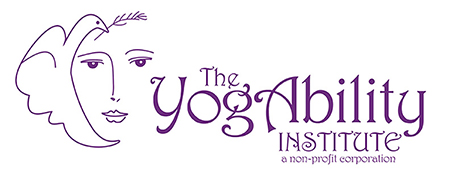Jerry is a tall, lanky 19-year-old with autism and gastro-intestinal issues. He began coming to YogAbility, a nonprofit organization, 10 years ago. He used to have frequent tantrums, screaming fits, and wore a protective helmet. Since he began yoga therapy, Jerry has grown tremendously in the way he communicates with people. He is more grounded. He even does poses on his own at home.
In a typical session, when he arrives Jerry is placed on his back for passive stretches. Jerry’s caregiver, Wendy, and I talk, touch, pull and push him, mainly encouraging him with praise and soft music playing. Whenever he jumps up, that action is respected and is used to create another pose. It could then be to sit on a chair and lean forward, with Jerry stretching out his legs and me lifting them. I follow his lead, rotating each knee on the chair and then extending him forward and down slowly to open the hips, groin and the psoas.
Jerry now lies flat on his stomach. I slowly lift one leg, then the other, followed by both at the same time. The locust pose for strengthening his back and his digestive system creates a slight beneficial pressure on the lower abdomen. For balancing/countering this, Jerry is rolled onto his back, hips lifted up and supported by a bolster under them. These inversions are excellent for him, relieving pressure, reversing circulation, and they are fun for him, too.
I then pull Jerry up into the half-shoulder stand and he smiles. The cat pose on hands and knees where he is straddling a bolster alleviates cries and groans–Jerry will rock forward and backward many times all on his own, organically and naturally. Having the cushioning and support of the bolster seems to be very effective.
The classic child pose for Jerry is a blessing. He straddles the large bolster, sits back onto his heels, and rests his upper body onto the bolster. Turning his head to the side, he relaxes here for a long time. I place both hands on his back. There is always contact and soothing talk, and Jerry feels the caring connection. Here we are free from the time constraints of studio classes. I can indulge Jerry in whichever pose he likes at the moment and for however long he wishes.
Jerry curls up on his side often, which is a lead-in to a lying down twist. Whatever he begins, I watch and follow. We also do seated twists, as partners. Then Jerry will jump up and head for the door, ready to go. Sometimes he heads to the kitchen where he knows there is water, and he’ll drink a large glassful. His attendants are fine people and work with me devotedly, learning all the time how to create the poses and adapting them for their benefit as well. Yoga is burn out prevention for caregivers.
The adaptive YogAbility exercises continue to help Jerry. They assist with his flexibility as well as his digestion, relieving air bubbles from his stomach and decreasing tension. Jerry’s mother, a psychotherapist, thinks that the sensory motor aspect of yoga has shown to be helpful to children with autism, but it is also “just another positive activity to fill a child’s day.”
I, the community support companion of Jerry, have also benefited from yoga throughout the past year. I’ve learned to slow down and incorporate yoga at least three times a week myself.
YogAbility is proof that all people, from infants to seniors, no matter what their condition, have the ability to move and enjoy their bodies beyond the limitations of their so-called disabilities.
http://www.specialneeds.com/children-and-parents/general-special-needs/yogability-people-disabilities
